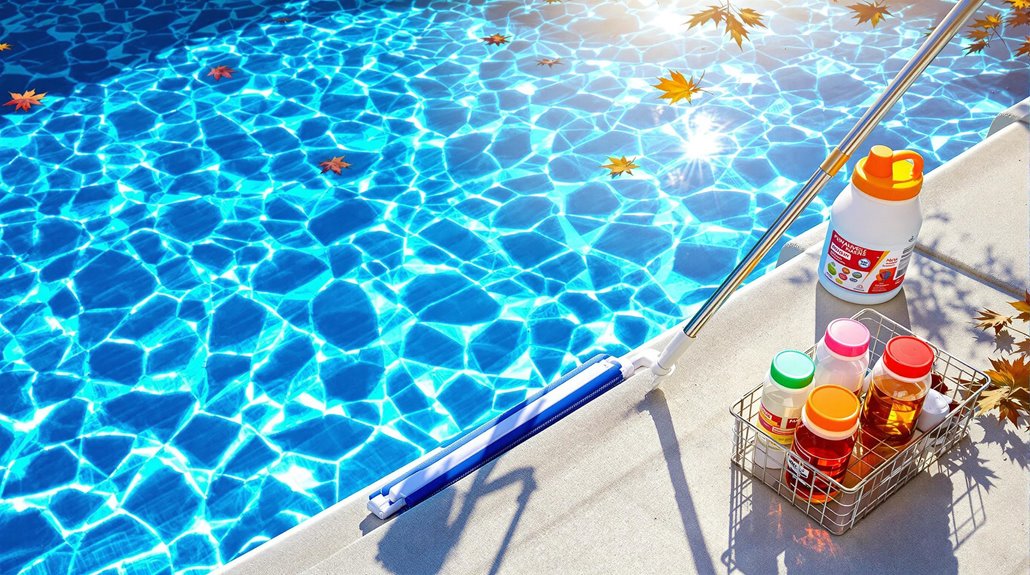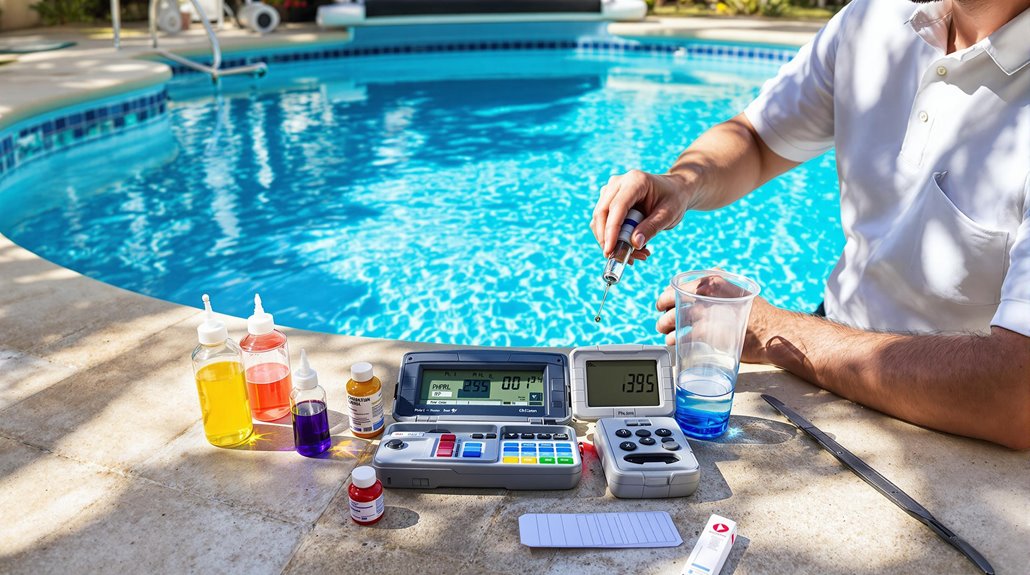To maintain a clean and safe pool year-round, you’ll need to follow a consistent maintenance schedule. Test chemical levels weekly, keeping pH between 7.2-7.8 and chlorine at 1-3 ppm. Skim daily, vacuum weekly, and run your pump 8-12 hours daily for proper filtration. Install proper fencing with self-closing gates, and secure chemicals away from children. Let’s investigate the essential seasonal adjustments that’ll keep your pool in top condition.
Essential Pool Maintenance Throughout the Seasons

Whilst maintaining a swimming pool requires year-round attention, each season brings its own unique set of maintenance tasks that you’ll need to address. During winter, you’ll want to install protective mesh or solid covers to shield your pool from debris and block excess sunlight. As spring arrives, you’ll focus on removing winter cover debris and reconnecting equipment, followed by essential shock treatments. Summer demands daily skimming and weekly vacuuming to manage increased swimmer activity and organic matter. Daily pool skimming helps prevent debris from sinking and causing stains on pool surfaces. Once fall comes, you’ll need to tackle leaf removal daily to prevent staining and plumbing clogs. Don’t forget to perform yearly structural inspections – checking for cracks in the walls, floors, and plumbing system. Regularly check for water level changes as this could indicate a potential leak in your pool. These timely repairs will prevent costly deterioration and keep your pool in prime condition. If your pool water becomes hazy, test and adjust your chemical levels immediately to prevent further cloudiness. Regular monitoring and treatment with algae prevention methods like proper chemical balance and circulation will help maintain crystal-clear water throughout the year. Maintaining proper pH balance is crucial for both swimmer comfort and the effectiveness of your sanitizing chemicals.
Safety Measures Every Pool Owner Must Know
Beyond regular maintenance tasks, proper pool safety stands in the foundation of responsible pool ownership. Creating a secure environment around your pool isn’t just about following regulations – it’s about protecting those you care about while maintaining your freedom to enjoy your investment.
- Install four-sided isolation fencing with self-closing, self-latching gates – this single step reduces drowning risks by 83% and provides peace of mind
- Secure your above-ground pool by removing ladders and steps when it’s not in use
- Add layers of protection with door alarms, lockable pool covers, and anti-climb systems for thorough security
- Keep pool chemicals locked away from children’s reach and remove toys from the pool area after use to prevent unsupervised temptation
Mastering Chemical Balance for Crystal Clear Water

Maintaining proper chemical balance forms the cornerstone of a sparkling, safe swimming pool. You’ll need to focus on five key elements: total alkalinity, pH, calcium hardness, chlorine, and cyanuric acid. Start by testing your total alkalinity weekly, aiming for 80-120 ppm, then adjust your pH to stay between 7.2-7.8 for best sanitizer performance.
Don’t overlook calcium hardness levels – keep them at 200-400 ppm to protect your equipment and prevent scaling. For effective sanitization, maintain free chlorine at 1-3 ppm and stabilize it with cyanuric acid at 30-50 ppm. Whenever testing, collect water samples from elbow-depth in multiple spots, and always wait 6-24 hours after adding chemicals to retest. Remember to shock your pool weekly or after heavy use to maintain crystal-clear water. If your chemical tests show unexpected results, follow a systematic troubleshooting process to identify and correct imbalances quickly.
Effective Cleaning Strategies for a Pristine Pool
A pristine pool requires more than just balanced chemicals – you’ll need an all-encompassing cleaning strategy to keep your water sparkling and inviting. You’ll find freedom from constant maintenance by implementing a systematic approach that combines daily surface control with regular mechanical cleaning. If your pump makes unusual noises, check for air in lines immediately to prevent damage. Regularly checking your filter’s pressure gauge helps ensure optimal performance and extends filter life significantly. Regular inspections of your pool heater will help prevent costly repairs and maintain efficient operation year-round. Maintaining crystal clear water requires consistent attention to detail and a comprehensive cleaning routine. Pool tile maintenance deserves special attention to prevent calcium buildup and staining along the waterline.
Keep your pool pristine by pairing chemical balance with a comprehensive cleaning routine that prevents maintenance headaches before they start.
- Skim your pool’s surface 1-2 times each day to remove floating debris, and don’t forget to clean those skimmer baskets weekly
- Vacuum the pool bottom in slow, parallel lines and brush walls daily, paying special attention to steps and corners
- Utilize natural cleaners such as baking soda for non-abrasive tile cleaning and vitamin C tablets for stubborn metal stains
- Run your pump 8-12 hours daily and maintain your filter system by backwashing at any time pressure rises 10 psi above normal
Frequently Asked Questions
How Long Should I Wait After Shocking Before Swimming?
Wait 8-24 hours after chlorine shock, 15 minutes after non-chlorine shock. Test water before swimming – chlorine must be under 3 ppm.
Can I Run My Pool Pump Less Often to Save Electricity?
Yes. Use variable-speed pump running longer at lower speeds to reduce energy use 50-75%.
What Causes Black Algae and Why Is It so Hard to Remove?
Black algae forms when chlorine levels drop and water circulation is inadequate. It resists removal due to its protective coating and roots that penetrate pool surfaces.
How Do I Remove Stubborn Metal Stains From Pool Surfaces?
Apply ascorbic acid powder directly to stained areas. Brush vigorously. Keep pH at 7.2. Add metal sequestrant to prevent future staining.
Why Does My Pool Water Keep Turning Cloudy After Heavy Rain?
Rainwater causes pool cloudiness by:
- Diluting chlorine levels
- Adding pollutants and debris
- Disrupting pH balance
Solutions: Rebalance chemicals and increase filter run time.

